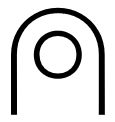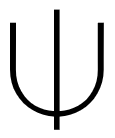I was looking today at a cardboard box that had the “this way up” symbol on it and wondered whether there is a Unicode value for it.

Apparently not. But there is an ISO code for it: ISO 7000 symbol 0623. It’s an international standard symbol for indicating how to orient a package. The name says it all: this way up.
There is a similar symbol in math and computer science: ↑↑. This is so-called up-arrow notation, introduced by Donald Knuth in 1976 [1].
In Knuth’s notation, ↑ indicates exponentiation, i.e. repeated multiplication, and ↑↑ indicates repeated exponentiation. There’s a little ambiguity here: we have to clarify in what order we apply exponentiation. Knuth stipulated that ↑↑ is right-associative, i.e.
So, for example, 5 ↑↑ 3 equals 5125, not 1255.
In general, n arrows means to repeatedly apply n-1 arrows. If we use ↑n as a shortcut for writing n up arrows, then we can define ↑n recursively as meaning we apply ↑n−1 n times.
What I find most interesting about Knuth’s notation is how rarely it is used. I don’t think it’s because anyone object’s to Knuth’s notation; it’s just that there isn’t much need for what the notation represents. It’s primary use may be theoretical computer science. There you sometimes want to construct functions that grow ridiculously fast, such as Ackermann’s function, and functions of the form a ↑n b are good for that.
This is curious. Multiplication is repeated addition, exponentiation is repeated multiplication, and so repeated exponentiation seems like a natural extension. I won’t say that it’s unnatural, but it is very uncommon.
Related posts
[1] Donald E. Knuth. “Mathematics and Computer Science: Coping with Finiteness”. Science. 194 (4271): 1235–1242.


